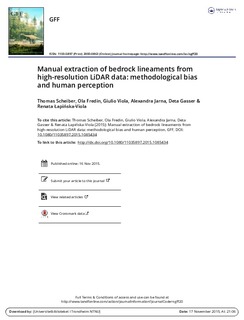| dc.description.abstract | Manual extraction of topographic features from Light Detection and Ranging (LiDAR) images is a quick, cost effective and powerful tool to produce lineament maps of fractured basement areas. This commonly used technique, however, suffers from several biases. In this contribution, we present the influence of (1) scale, (2) illumination azimuth and (3) operator, which significantly affect results of remote sensing expressed as number, orientation and length of the mapped lineaments. Six operators (N1–N6) with differing experience in remote sensing and different Earth sciences backgrounds mapped the same LiDAR DEM of a fractured bedrock terrain located in western Norway at three different scales (1:20.000, 1:10.000, 1:5.000) and illuminated from three different azimuths (045°, 180°, 315°). The 54 lineament maps show considerable output variability depending on the three factors: (1) at larger scales, both the number and the orientation variability of picked lineaments increase, whereas the line lengths generally decrease. (2) Linear features oriented perpendicular to the source of illumination are preferentially enhanced. (3) Inter-operator result reproducibility is generally poor. Operators have different perceptions of what is a lineament. Ironically, this is particularly obvious for the results of the “most experienced” operators, seemingly reflecting a stronger conceptual bias of what lineaments are and an operational bias on how they should be mapped. Based on these results, we suggest guidelines aimed to improve the reliability of remote sensing lineament interpretations. | nb_NO |
